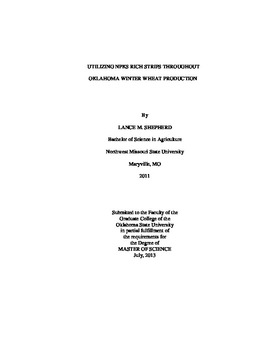| dc.description.abstract | Both temporal and spatial variation plays a major role in nutrient requirements and availability. This study was conducted to improve nutrient use efficiencies, demonstrate ability to visually identify nutrient needs throughout a cropping season, along with the evaluation of both soil nutrient recommendations across divergent environments and current producer fertilization management schemes. This project is an extension of the N-rich strip concept which is used to identify in season nitrogen deficiencies. Nutrient rich strips of nitrogen (N), phosphorus (P), potassium (K), and sulfur (S) were applied at 59 site years with 236 comparisons across Oklahoma, on multiple soil types with a wide range of environmental conditions and wheat varieties. Nutrient rich strips were applied at a rate of 257.6 kg ha-1 of product to a 1.8 by 30.5 meter strip in producer fields. Urea (46-0-0), triple super phosphate (0-20-0), potash (0-0-52) and gypsum (0-0-0-19) were used for sources of nitrogen, phosphorus, potassium and sulfur respectively. Composite surface (0-15 cm) and subsurface (15-45 cm) soil samples were taken prior to application for soil nutrient recommendations. Normalized difference vegetative index (NDVI) data was collected from the nutrient rich strips and the farmer practice, where the GreenSeeker<sup>TM</sup> sensor was used to estimate biomass. At maturity three one m2 subplots were hand harvest from each strip. Samples were threshed, grain weight recorded and grain samples analyzed for N, P, K and S content. Of 59 locations and 236 comparisons 17 responses were documented. Most responses were due to underestimated yield goal, overestimated NUE or identified by soil testing results. In the two years this study was conducted winter wheat grain yield was increased with the addition of N at seven locations, P at seven locations, K at three locations. Over the 59 locations sampled there was no response to additional S fertilizer. Soil testing proved to be an adequate method for nutrient recommendation. At 75% of the locations yield was maximized by the producer with his or her NPKS management system. The study was however unable to identify if the management strategies optimized yield economically. | |
